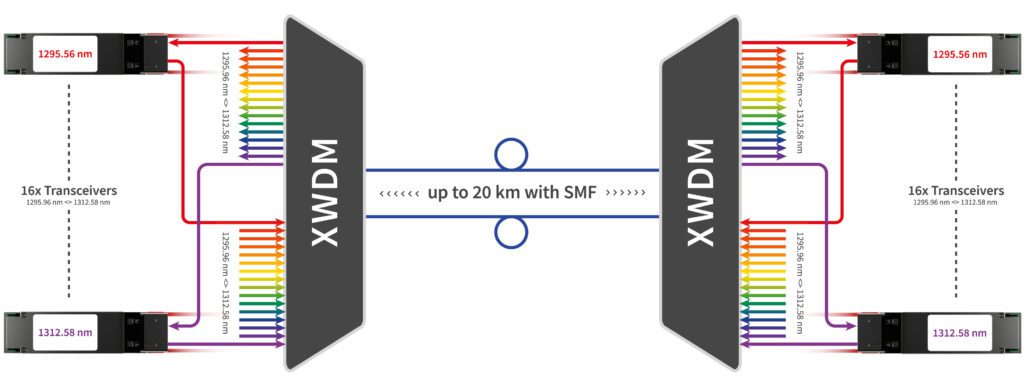Truly 100G passive DWDM solution – Our answer O-Band
WDM (Wavelength Division Multiplexing) is a transmission technology that uses a single optical fiber to simultaneously transmit multiple optical carriers of different wavelengths in optical fiber communications. All possible wavelengths are divided into several bands and referring to the ITU-T standards, we know that single-mode fiber is divided into six bands. They are O, E, S, C, L, U band.
Did you know that the O-Band wavelength is the first wavelength band used in optical communication history? Well yes, the O-Band wavelength is the original band with wavelengths from 1260 to 1360nm. E band can be mentioned as well as the expansion of O band, but it is rarely used. Next up is the S band. S band is mostly used for PON (passive optical network) systems and actually optical fiber loss is lower than it is in O band. The C band is moreover a conventional band. Why? Firstly, C stands for Conventional, but also C band has the lowest loss, which means that there is a possibility for long-distance transmission systems. C band ranges from 1530 nm to 1565nm. L band (Long wavelength Band, 1565-1625nm) is often used when the C-band is insufficient to meet the bandwidth requirements, but it also has the second lowest loss. Lastly U band as well as known as ultra long band 1625-1675 nm, which is not mostly used.
| xWDM wavelength bands | |||||
|---|---|---|---|---|---|
| Optical fiber wavelength band | Band description | Wavelength Range (nm) | |||
| O-band | Original | 1260 to 1360 | |||
| E-band | Extrended | 1360 to 1460 | |||
| S-band | Short | 1460 to 1530 | |||
| C-band | Conventional | 1530 to 1565 | |||
| L-band | Long | 1565 to 1625 | |||
| U-band | Ultra-long | 1625 to 1675 | |||
O-band stands for Original Band as it was the first wavelength band introduced. The O-band is extensively used for high-speed Ethernet transmission, such as IEEE 100GBASE-LR4 or 400GBASE-LR8. The O-band is known by its use of silica glass, which has a zero material dispersion wavelength. This small dispersion allows a high-speed optical transmission without dispersion compensation schemes. While using no dispersion compensation schemes it offers advantages in both the initial investment and operation cost. In short, lower transceiver price and lower power consumption. The solution is designed for customers who need more then one 100G connection in medium length distance. Taking into account the advantages, there are some disadvantages that as well need to be known. Regarding that the O-band dispersion is zero, the optical fiber attenuation is increased. Because of the increased attenuation there is a need for stronger lasers in the transmission and products in the O-band are used only for connection over short distances.
O-band passive DWDM 100G solution allows to transmit up to 16x 100G data streams in 20/30km without need of signal amplification!
O-band optical wavelength range is used in many different solutions in nowadays telecommunication systems. One of them is xWDM system whom EDGE Optics offers single-wavelength 100G QSFP28 O-band xWDM pluggable optical transceivers and passive O-band MUX / DeMUX filter equipment. Transceivers are operating over O-band with 16 wavelengths from 1295nm till 1312nm in LAN-WDM grid at 200GHz channel spacing. Single Mode G.652 optical fiber is required for these modules to operate without issues. Connecting Single channel link from one QSFP28 directly to other QSFP28 – without MUX filters the maximum link distance can be up to 30km. But if 8Ch MUX / DeMUX filter system is used then due to filter insertion loss maximum link distance shrinks to 25km. And respectively with 16Ch MUX / DeMUX filter – 20km.
100G QSFP28 O-band xWDM transceivers are designed with CAUI-4 host electrical interface which contains 4 NRZ lines. This approach assures compatibility with most of the switch manufacturers. The 4 electrical NRZ lines are appended together with the help of an in-module gearbox to one PAM4 optical signal line with integrated FEC. This optical line is the main modulated signal source which is driven by a laser on a specific wavelength channel.
O-band passive MUX / DeMUX filter solution allows transmitting a maximum of 1.6Tbps of data in a 20km distance. This is achieved with the solution No 1, with 16ch MUX / DeMUX filters and all channel 100G transceivers.
Solution No 1 – Double Fiber O-Band 100G passive connection with 16x 100G-QSFP28 O-Band transceivers, and two Double Fiber O-band 16 channel passive filters:
Solution No 2 – Single Fiber O-Band 100G passive connection with 16x 100G-QSFP28 O-Band transceivers, and two Single Fiber O-band 8 channel passive filters:
EDGE Optic O-band 100G transceiver portfolio:
| 100G O-Band QSFP28 Optical Transceivers | ||
|---|---|---|
| SKU | Parameters | |
| OWDM-100G-Q28-30-000 | Tx/Rx. 1303.45nm/1290-1325nm, O-Band 200 Ghz grid | |
| OWDM-100G-Q28-30-002 | Tx/Rx. 1302.31nm/1290-1325nm, O-Band 200 Ghz grid | |
| OWDM-100G-Q28-30-004 | Tx/Rx. 1301.18nm/1290-1325nm, O-Band 200 Ghz grid | |
| OWDM-100G-Q28-30-006 | Tx/Rx. 1300.05nm/1290-1325nm, O-Band 200 Ghz grid | |
| OWDM-100G-Q28-30-008 | Tx/Rx. 1298.93nm/1290-1325nm, O-Band 200 Ghz grid | |
| OWDM-100G-Q28-30-010 | Tx/Rx. 1297.80nm/1290-1325nm, O-Band 200 Ghz grid | |
| OWDM-100G-Q28-30-012 | Tx/Rx. 1296.68nm/1290-1325nm, O-Band 200 Ghz grid | |
| OWDM-100G-Q28-30-014 | Tx/Rx. 1295.56nm/1290-1325nm, O-Band 200 Ghz grid | |
| OWDM-100G-Q28-30-084 | Tx/Rx. 1312.58nm/1290-1325nm, O-Band 200 Ghz grid, | |
| OWDM-100G-Q28-30-086 | Tx/Rx. 1311.43nm/1290-1325nm, O-Band 200 Ghz grid | |
| OWDM-100G-Q28-30-088 | Tx/Rx. 1310.28nm/1290-1325nm, O-Band 200 Ghz grid | |
| OWDM-100G-Q28-30-090 | Tx/Rx. 1309.14nm/1290-1325nm, O-Band 200 Ghz grid | |
| OWDM-100G-Q28-30-092 | Tx/Rx. 1308.00nm/1290-1325nm, O-Band 200 Ghz grid | |
| OWDM-100G-Q28-30-094 | Tx/Rx. 1306.85nm/1290-1325nm, O-Band 200 Ghz grid | |
| OWDM-100G-Q28-30-096 | Tx/Rx. 1305.72nm/1290-1325nm, O-Band 200 Ghz grid | |
| OWDM-100G-Q28-30-098 | Tx/Rx. 1304.58nm/1290-1325nm, O-Band 200 Ghz grid | |
For any requirements and information be sure to contact us!





